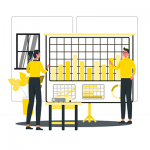Productivity is a multi-headed beast. It’s a cocktail consisting of motivation, culture, collaboration, focus, goal setting, and time management, as well as controlling ambiguity to make one simple goal: keeping your staff working.
Added into this mix are distractions. If you are reading this article, you probably know that you can’t wave your finger at distracted employees and say, “Get back to work!” But, you have to handle distractions in some, non-intrusive manner–it’s hard work.
Having been a manager for a while, I do feel that every once in awhile certain people need to be reminded that getting work done–not planning an event or talking about the weather–is the main reason why they are paid to come to the office. Yet, as odd as that sounds, for many workers today, work-life and home-life have become inextricably entwined, whether it be checking Facebook, texting, or leaving early to pick up their sick kid from school. Juggling this balance is a necessity of work today and as a manager, we need to build a culture around this while still remaining focused and being productive. A few times in this series, I have mentioned that a manager’s main job is getting work done, and an integral part of this is keeping their team productive.
A manager’s main job is not to be liked. I have found this is sometimes difficult for leaders and managers today to understand. Some leaders feel that it’s a priority for their team to like them; they want to be “a part of the gang” and not just a “manager”–this is problematic.
As much as you may want your team to see you as a friend, that will not happen. Once you get the manager role (especially within knowledge workers), you are no longer just a coworker. Most knowledge workers view managers with contempt and as a part of the bureaucracy. Putting that aside for this article, trying to be “one of the gang” is simply not a good management tactic. This is because, inevitably, you’re going to have to fulfill your manager role and make some unfavorable decisions, reprimand someone, or toe-the-company-line. By portraying yourself as “one of the gang,” once you make an unfavorable decision, your team is going to respond more negatively than they would have you separated yourself from the beginning–they’re going to view you as inauthentic, which could lead to more problems. However, having a productive team and having a team that likes you are definitely not mutually exclusive. At the same time, they are not mutually inclusive.
What Does it Mean to “Be Productive”?
The story portrayed in the comic above is an extreme case, and I hope it doesn’t happen to you! But the moral of the story is that so many things can hinder productivity. From gossip, to uncertainty and ambiguity, to a staff member being rightfully fired, to removing an office ping-pong table––so many things can shut down productivity; but, as a manager, it is your job to keep your team on the right track towards success.
Keeping your team productive is going to vary based on your own organization. But, what is not keeping your team productive is being a micromanaging despot who tracks every billable hour, minute, and second, ultimately making it annoying to work under you. When I talk about keeping a team productive, I mean maintaining focus on tasks, understanding the project vision and goals, having open communication, fostering collaboration, and minimizing distractions; it starts with creating a culture. We explored this idea in a past Leader’s Pulse installment, How to Build a Strong Culture Across Teams. Essentially, the work culture you create and mold as a manager must be conducive to work and keeping teams productive.
Productivity: The Human Side of Development
One part of software development not taught much in school is the human side. Yet, for managers and leaders, it has to be the primary focus of our work. Many testing practices by nature include humane aspects. Extreme Programming (XP) sparked the conversation of “the human side,” with its 5 values including respect, courage, and feedback, and a foundation practice of XP being working at a “sustainable pace.” Today’s Agile principles include face-to-face communication as much as possible. In Scrum, the primary job of a Scrum Master is removing obstacles. For modern managers and leaders, removing obstacles keeps the team productive. The more you learn about XP, Agile, and Scrum, the better you will be at fostering and supporting productivity while being humane about it.
Another major aspect of this human side of the development is the fact that we are humans, not machines. While a machine can work endlessly without breaks, we as humans cannot; we get tired, we get emotional, we become uninspired––we need breaks! Taking breaks is a very necessary (but sometimes frowned upon) practice in productivity. I recall a study I once came across that said people who smoke tend to be the happiest at work. Why? Because they take smoke breaks outside. Now, I’m not advising you to take up smoking, but there are benefits to taking small breaks throughout the day. Go for a short walk. Grab a cup of coffee from down the road. Run a short errand. Whatever you do, just stop eating lunch at your desk and get out of the office for a short while––your focus, creativity, and productivity will thank you.
Productivity: The Bigger Picture
How do you keep the team focused on their work? Include them into your overall vision and goals (i.e. “Bigger Picture”) of the work, product, or service. In periods of greater ambiguity, being enrolled in the vision helps teams prioritize and reprioritize. It helps shift focus when tasks are delayed and to keep working when obstacles get in the way. Having a bigger vision than the immediate task at hand is key to working with knowledge workers who are accustomed to juggling multiple work items.
Productivity: Be Lean. Cut Waste.
If you read my columns, you know that talking about Lean Software Development (LSD) is one of my favorite topics. I have written at length about Quality at Every Step, Just in Time, and Deliver as Fast as Possible––especially when it comes to testing results. But, I don’t normally write about the primary Lean topic of Cut Waste. I have always thought that this topic was well understood since many people have written at great length about it. To borrow the list of the top defined wastes of LSD, I will reference the experts Mary and Tom Poppendieck who wrote the book on LSD.
They list wastes as:
For a more comprehensive discussion on waste––or to start a “Waste Brainstorm”––you can visit this site.
A few more things I would add to this list are:
- Early or Over-Documentation
- Miscommunication
- Waiting on Information / Time Zone Issues
- Waiting for Test Results
I would suggest you do a “waste assessment” or waste analysis for your personal work environment: just sit with your team and do a brainstorming session about things that cut into productivity.
I do see this cut waste effort as a really important and essential practice. Of course, for any manager or leader, you want to be efficient and keep the team as productive as possible. But in addition to this, particularly with knowledge workers and some Millennial workers, process inefficiencies are supremely frustrating––so much so that many knowledge workers throw process administration, management, and measurement into the waste category and resist it at all costs. We need to minimize processes and instead use them as a structure to enable and empower people, rather than hold them back and slow them down.

Productivity: Motivation
part upon attraction and retention. In Silicon Valley (where I live), tech workers for software projects are in very high demand and thus have a dynamic job market; they enjoy more job mobility than other workers and can change roles quickly with ease. This very often puts employers on the defensive, forcing them to make job, salary, environment, and perks decisions that have not been done in the past.
I never like talking about employee motivation with teams or leaders because the conversation invariably has to get over the salary hurdle. Salary is not the primary motivator for knowledge workers, especially not for attraction and retention. Most tech workers take a better than average salary for granted. No arguments. Go do your own research. One of the defining characteristics of knowledge workers is that they are motivated primarily by the work itself––it’s why we chose to go into software development. There are a variety of reasons here, not the least of which is knowing that this is a higher salary industry. Many people who work in the software are starting out at a relatively higher position than their peers. For me to say “primarily by the work itself” is a broad statement; obviously, this varies culturally and geographically. For some people, there may be other reasons. The studies merely recognize trends, so it doesn’t apply to every individual.
With job motivation, it is a puzzle. Motivation is made up of many pieces: “the work itself,” team dynamic, flexibility in hours, level of autonomy, how cool the company is, the stock price, how much free food, how good the coffee is, and how many ping pong tables are in the office; this is when people begin realizing that salary is not the primary motivator. Where I work in Silicon Valley, a primary attraction and retention item is commute time. It’s multifaceted and––in the case of the ping pong table––sometimes extreme. Certain motivational factors are subjective based on the individual, but the one universal motivator that managers can emphasize on is the work itself. So, let’s get over the job motivation puzzle and focus on the key item: the work itself. Keep the teams focused on the work. When distractions happen, re-focus on the work.
Productivity: Recognition & Rewards
Recognition and reward is a common topic for managers. It is a hot topic for managing any people and a particularly unique topic for managing Millennials (although, I must say right now it is not unique to Millennials). All employees want recognition. All employees want rewards for their work. For some employees, the salary is enough; for others, it is not. Salary is merely the most basic reward. There are so many other outlets for recognition and reward, and the topic has already been written on extensively. You can go do some research yourself, but here are a few examples: a parking spot, work from home days, flexibility in hours, etc.
It is an important topic for knowledge workers whose work is often unseen and when the various contributions of individuals on the team are sometimes difficult to measure. But you must know as a manager and a leader that recognition and reward is a key part of your job and a prime motivator to keep people productive.
The most critical part of my job as a manager is to show my appreciation to my team and say thank you. “Thank you” is free. “Thank you” is a foundational part of any leader’s workday. I have worked with various managers who, for some reason, find it difficult to thank people for the job they do. For a while, I had a manager on a team with me who said, “I don’t know why I have to thank people for just doing the job that they are paid for.” Big surprise––no one liked working on his team.
On the other hand, I also don’t pass out “thank you’s” indiscriminately; doing this minimizes their meaning. I thank people for a variety of reasons, from completing things on time, to doing them well, or even from acting on their emotional intelligence. As a leader, you will need to develop your own “thank you” meter. Remember to be generous–“thank you” is free.
Summary
This installment of Leader’s Pulse was quite eclectic; we covered a lot of different topics, but they all relate back to one thing: your main job as a manager is to keep teams productive. There are many ways to inspire productivity within your team, like motivators and perks including salary, benefits, or even an office ping pong table. Remember, at the end of the day, we are all human. Distractions are going to inevitably work their way into our lives, but it is important that you as a leader address and manage these distractions humanely; I’ll quickly reference back to the manager who never thanked his employees: no one liked being on his team. As a leader, you may not always be liked–that is just a part of the job at hand. But, as I stated before, being liked and being productive are not mutually exclusive things, nor are they mutually inclusive; you will have to develop mannerisms and methods that work for your organization and your team. There is no overarching best practice for promoting productivity. Sometimes, it’s as simple as saying “thank you,” and other times, it’s a change in salary. The ways in which you keep your team productive are going to evolve as you grow as a leader.




















